The following are a few snaps from my recent attendance at the symposium: Rethinking “Pictorialism” held in conjunction with the exhibition now playing at the Princeton University Art Museum in New Jersey: Clarence H. White and His World: The Art & Craft of Photography, 1895-1925. On exhibit at Princeton through January 7, 2018, the show will then travel to the Davis Museum at Wellesley College (MA) from 02-07-18 to 06-03-18; The Portland Museum of Art in Maine from 06-30-18 to 09-16-18 and the Cleveland Museum of Art in OH from 10-21-18 to 01-21-19.
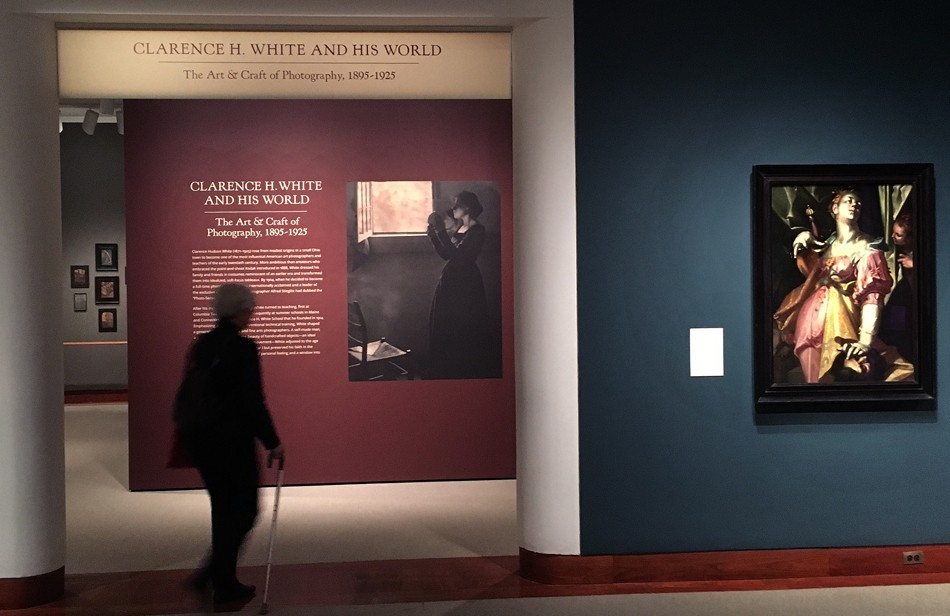
A visitor enters the exhibit “Clarence H. White and His World: The Art & Craft of Photography, 1895-1925” at the Princeton University Art Museum during the October, 2017 weekend in which a symposium devoted to Rethinking “Pictorialism” in context with White’s work and those of his contemporaries was discussed. Photo by David Spencer for PhotoSeed Archive.

Two men from two very distinct photographic worlds: Seen at center ca. 1900 at around 25 years of age, Clarence H. White, with hair slightly unkempt as befitting one whose energies were certainly taxed for familial obligations combined with lofty personal ambitions related to the nascent field of art photography, (and the necessity of keeping his day job) was compared with a mentor at left: Alfred Stieglitz, during a symposium paper. Sarah Greenough, far right, senior curator and head of the department of photographs at the National Gallery of Art in Washington, D.C., compared both as part of her keynote address: Alfred Stieglitz, 291, and the Nursery of Genius: 100 Years Later. The symposium- Rethinking “Pictorialism” American Art and Photography, 1895 to 1925, was held at Princeton University on October 20-21, 2017 in conjunction with the in-progress exhibition on Clarence White at the University art museum. Photo by David Spencer for PhotoSeed Archive.
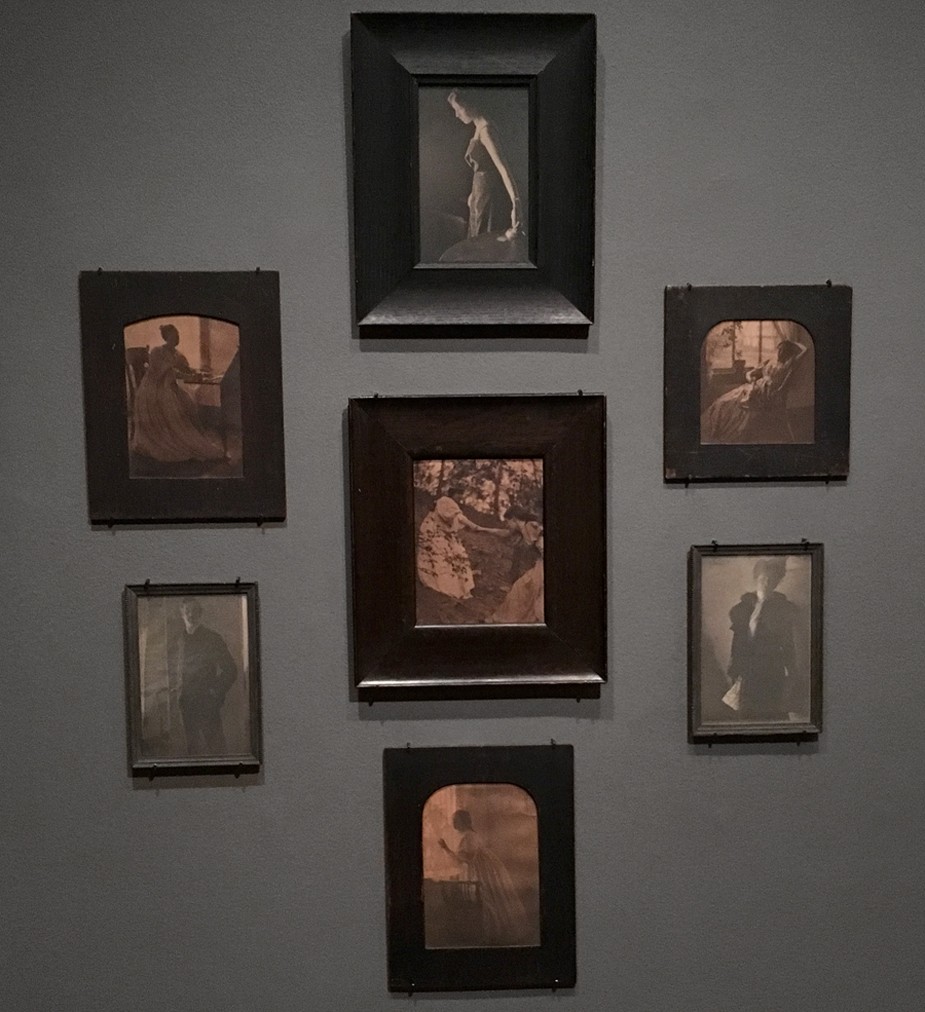
A wall grouping of original Clarence H. White photographs in their original wood frames are on display as part of the exhibit: “Clarence H. White and His World: The Art & Craft of Photography, 1895-1925” now at the Princeton University Museum of Art through early 2018. An excerpt of the wall label: “These photographs are among the few pictorialist works from the late 1890s that survive in their original exhibition frames. Photo by David Spencer for PhotoSeed Archive
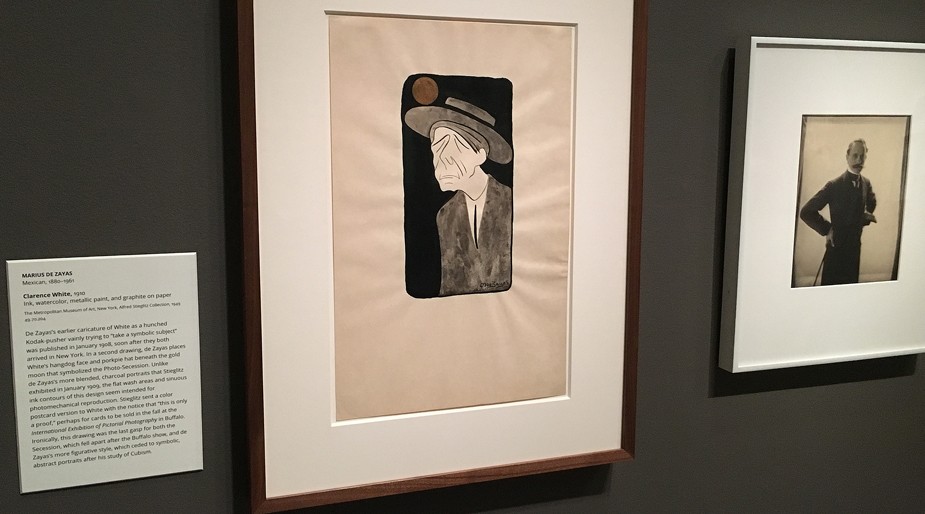
A caricature drawing of Clarence White done in 1910 by Mexican artist Marius De Zayas (1880-1961) is included in the exhibit on loan from the Metropolitan Museum of Art. Accompanied by a vintage portrait of the artist by White at far right, an excerpt from the wall caption reveals: “…de Zayas places White’s hangdog face and porkpie hat beneath the gold moon that symbolized the Photo-Secession. Unlike de Zayas’s more blended, charcoal portraits that Stieglitz exhibited in January 1909, the flat wash areas and sinuous ink contours of this design seem intended for photomechanical reproduction.” Note: caricature drawings by the artist appeared in the journal Camera Work XXIX in 1910 and CW XLVI in 1914. Photo by David Spencer for PhotoSeed Archive.
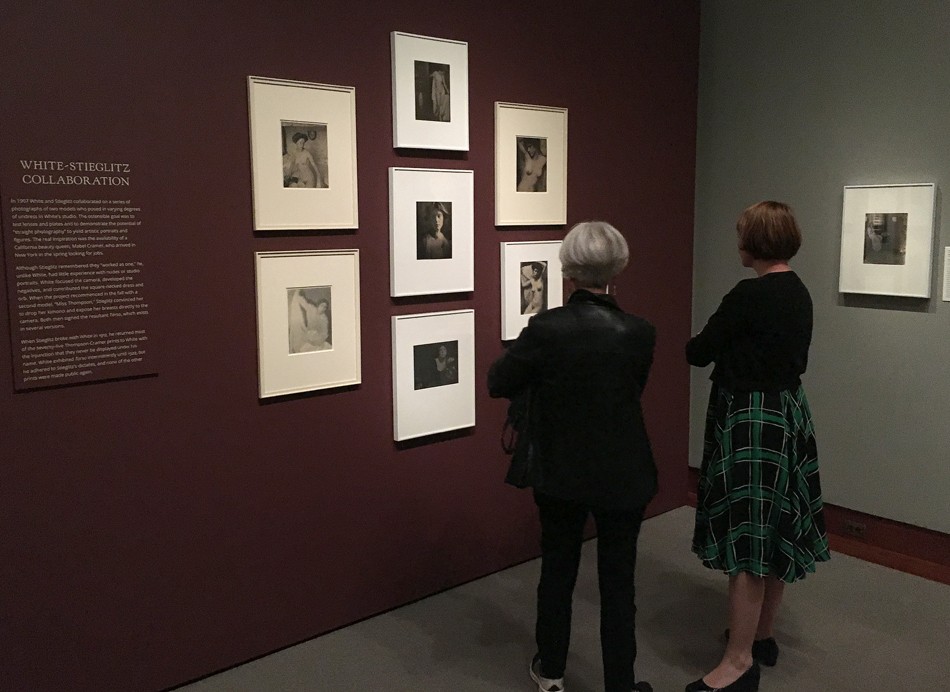
Visitors take in a select grouping of vintage photographs taken in 1907 by Clarence H. White and Alfred Stieglitz in White’s New York City studio that are part of the exhibit “Clarence H. White and His World: The art & Craft of Photography, 1895-1925” now at the Princeton University Museum of Art. An excerpt from the wall label: “In 1907 White and Stieglitz collaborated on a series of photographs of two models who posed in varying degrees of undress in White’s studio. The ostensible goal was to test lenses and plates and to demonstrate the potential of “straight photography” to yield artistic portraits and figures. The real inspiration was the availability of a California beauty queen, Mabel Cramer, who arrived in New York in the spring looking for jobs.” Photo by David Spencer for PhotoSeed Archive.
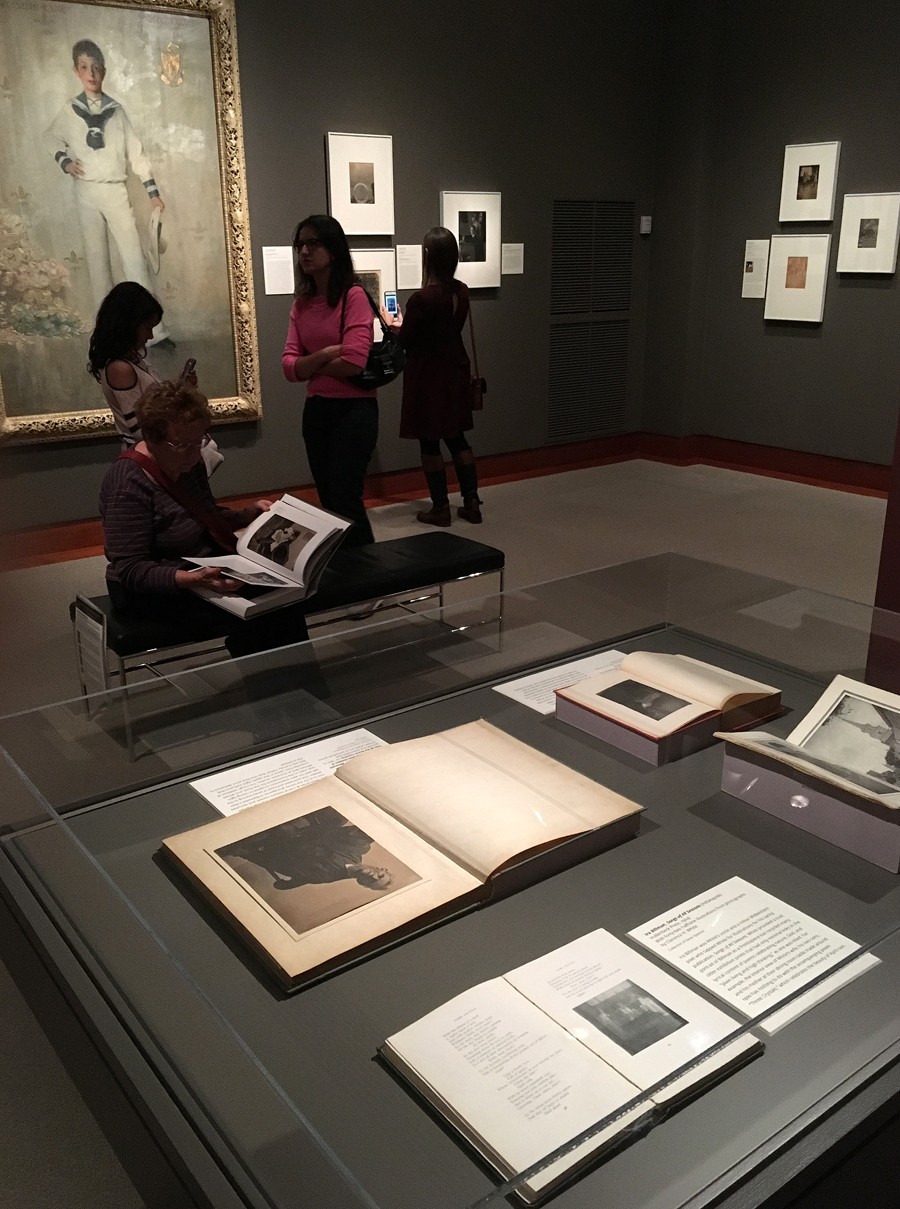
In one exhibit gallery, a display case seen at bottom contains examples of Clarence White’s published work. In the early 20th Century, his interest in commercial illustration lent itself to the publication of several articles as well as volumes featuring staged genre photographs, including a photogravure-illustrated edition of the best-selling Irving Bacheller novel Eben Holden published by the Lothrop in 1903 and Songs of All Seasons in 1904. The latter volume, lent by this website for the exhibit and written by White’s uncle Ira Billman contained the following label excerpt: “White provided a bust portrait of Billman as a frontispiece but recycled many older exhibition prints that had only minimal links to the lyrical content of poems celebrating nature, God, and “Plain living and high thinking,” as one was titled.” On another label, for a bound collection of work prints for Eben Holden and the article “Beneath the Wrinkle”, we learn White recruited a bearded gent named John Miles Jones at a Newark, Oh market who served as the “heroic protagonist of Bacheller’s Eben Holden”. (seen at far left at frame bottom) Photo by David Spencer for PhotoSeed Archive.

Perhaps Clarence White’s greatest legacy was his teaching career. On the exhibit wall at center, a portrait of the American painter Arthur Wesley Dow taken by White around 1908 is shown with an original painting by Dow at far left showing the influence of Japanese design. White’s transition from Newark to New York City in 1906 began a new chapter of teaching by the photographer, who soon made the acquaintance of artist and arts educator Arthur Wesley Dow, (1857-1922) who hired White as an instructor at Columbia University’s Teachers College in 1907. White would go on to found his own groundbreaking schools of artistic photography utilizing a modern pedagogy learned from Dow among others: first in Maine beginning in 1910 and then in New York City in 1914. Photo by David Spencer for PhotoSeed Archive.

In the final gallery exhibition display case, an original letter to Clarence White’s widow Jane White by Alfred Stieglitz is displayed, with this modern-day reader struck by the author’s self importance revealed in the letter’s conclusion at an inopportune time: writing from Lake George, New York, the elder statesman of American pictorial photography pens a belated note of condolence dated September 25, 1923: “My dear Mrs. White: I have refrained from writing to you before this. Life has taught me that words mean little in days like ours. But I want you to know that it did shock me to hear of Clarence’s sudden death-so far away from home. He died in harness. A man can wish no more. Naturally my thoughts of him go back to the “early” days- when I think he was happier- He followed his lights-as I suppose we all do for we seem to have no choice. – I look at Camera Work & am glad it exists. – Photo by David Spencer for PhotoSeed Archive.
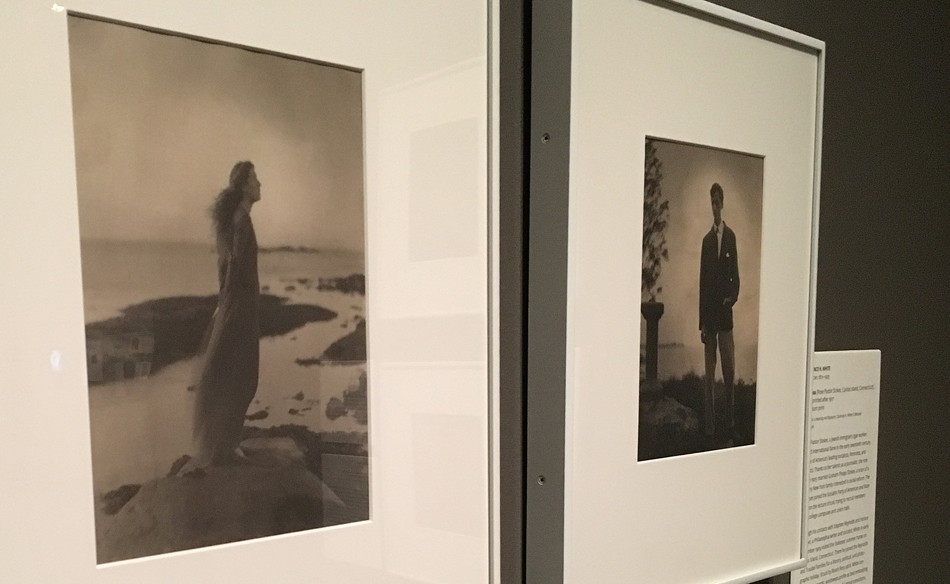
The exhibit features marvelous images by Clarence White held in the Clarence H. White Collection at the Princeton University Art Museum, like this stunning full-length portrait titled The Sea taken of socialist, feminist and activist Rose Pastor Stokes in 1909 and printed after 1917 as a Palladium print. A committed socialist himself, White photographed Stokes during a visit to her and husband Graham Phelps Stokes (portrait of him at far right of frame by White) summer home on Caritas Island, CT. A label excerpt: “Struck by Rose’s fiery spirit, White conceived this romantic, windswept profile as best embodying her fierce independence and powerful moral convictions.” Note: this portrait used as the cover illustration for the exhibit’s accompanying monograph volume. Photo by David Spencer for PhotoSeed Archive.



